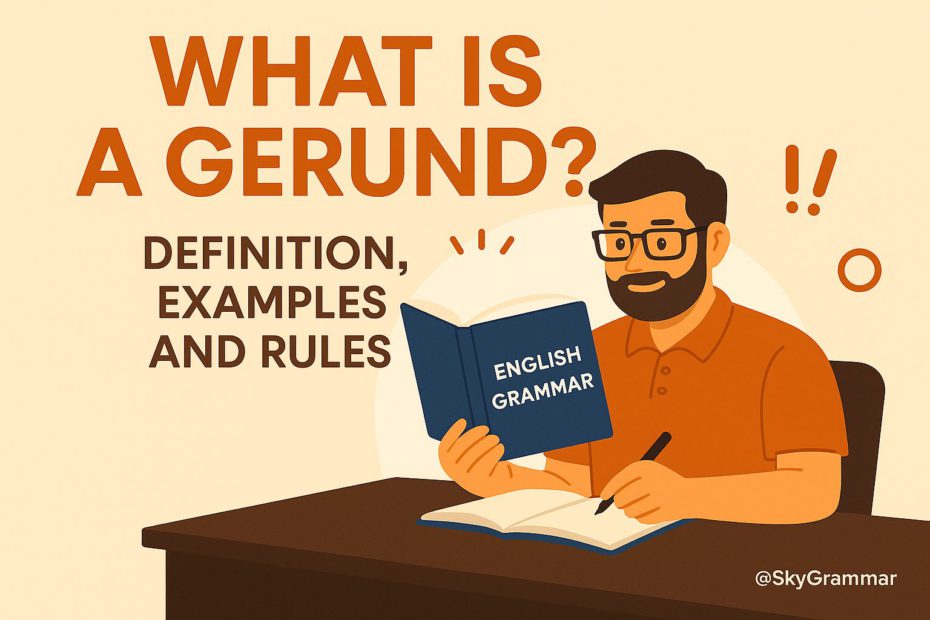Understanding English grammar can sometimes feel like decoding a secret language. One topic that often confuses learners is the gerund. Despite its fancy-sounding name, a gerund is a simple yet essential concept in English. In this guide, we’ll break down what a gerund is, how it’s used, and how to recognize it in everyday sentences.
What is a Gerund?
A gerund is a verb ending in -ing that serves the role of a noun within a sentence. It looks exactly like a present participle (e.g., running, swimming, eating), but it behaves like a noun in a sentence.
Examples of gerunds:
- Running is good for your health.
- She enjoys reading in her free time.
- Cooking takes patience and creativity.
In each of these examples, the word ending in -ing is not describing an action being performed but is being used as the subject or object—just like a noun.
How to Identify a Gerund
Identifying gerunds becomes easier once you know what to look for. Ask yourself these questions:
- Does the word end in -ing?
- Is it serving the role of a noun in this sentence?
If both conditions are met, then the word is functioning as a gerund.
Gerund vs. Present Participle
Gerunds are often mistaken for present participles due to their identical -ing form. The key difference is function.
- Gerund = noun
Example: Swimming is relaxing. - Present participle = adjective or part of a continuous verb tense
Example: I am swimming in the pool.
In the first sentence, “swimming” is the subject (a noun), while in the second, it’s part of the verb phrase “am swimming.”
Uses of Gerunds in Sentences
Gerunds can appear in several grammatical roles, such as:
1. As the Subject of a Sentence
When placed at the beginning of a sentence, a gerund functions as the subject.
Examples:
- Learning new languages is exciting.
- Traveling opens your mind.
2. As the Object of a Verb
Some verbs are followed by a gerund rather than an infinitive.
Examples:
- I enjoy baking.
- They admitted cheating on the test.
Common verbs that are followed by gerunds include:
- enjoy
- avoid
- consider
- finish
- suggest
- recommend
- admit
3. As the Object of a Preposition
Gerunds often follow prepositions and function as the object.
Examples:
- She’s interested in photography.
- He left without saying goodbye.
Keep in mind: When a verb comes after a preposition, it should appear in its gerund (-ing) form.
4. As the Subject Complement
A gerund can also appear after a linking verb to rename or describe the subject.
Examples:
- Her favorite hobby is painting.
- His passion is teaching.
Gerund Phrases
Just like nouns, gerunds can be part of gerund phrases, which include the gerund and any modifiers or objects associated with it.
Examples:
- Eating spicy food can upset your stomach.
- Writing long essays requires concentration.
In both examples, the entire phrase acts as the subject of the sentence.
Verbs Followed by Gerunds
Some verbs in English are always (or usually) followed by gerunds rather than infinitives. Here are a few common ones:
- admit
- avoid
- consider
- delay
- enjoy
- finish
- keep
- mind
- miss
- practice
- suggest
Example Sentences:
- She avoids eating junk food.
- I suggest taking the earlier train.
Common Mistakes with Gerunds
Here are a few typical mistakes learners make when dealing with gerunds:
❌ Mixing Up Infinitives and Gerunds
Some verbs must be followed by a gerund, not an infinitive (to + verb).
Incorrect: I enjoy to swim.
Correct: I enjoy swimming.
❌ Using a Base Verb After a Preposition
A verb following a preposition must always be in gerund form.
Incorrect: He’s good at draw.
Correct: He’s good at drawing.
Gerund vs. Infinitive
It’s important to note that some verbs can be followed by either a gerund or an infinitive—but the meaning may change.
Examples:
Remember + gerund = remembering something from the past
- I remember meeting her at the party.
Remember + infinitive = remembering to do something
- Remember to lock the door.
Some verbs that change meaning based on whether they’re followed by a gerund or infinitive:
- remember
- stop
- forget
- try
Understanding this difference can help you avoid subtle grammar errors.
Gerunds in Real Life
Gerunds are everywhere in English, and once you start spotting them, you’ll see how useful they are. Whether you’re writing an email, reading an article, or listening to a conversation, gerunds help form the backbone of natural-sounding English.
Real-World Examples:
- “Thanks for calling me back so quickly.”
- “I love traveling to new places.”
- “Dancing is not really my thing.”
Quick Recap
Let’s summarize what we’ve learned about gerunds:
- A gerund is the -ing form of a verb used as a noun.
- Gerunds can serve as subjects, objects, and complements.
- Gerunds commonly follow specific verbs and prepositions in English grammar.
- Gerund phrases include the gerund and any associated modifiers or objects.
- Don’t confuse gerunds with present participles—they serve different grammatical roles.
Final Thoughts
Gerunds are a powerful tool in English grammar. They allow verbs to function as nouns, giving your language more flexibility and fluency. Whether you’re writing formally or speaking casually, understanding how gerunds work will help you express yourself more clearly and naturally.
So the next time you find yourself enjoying reading, practicing speaking, or avoiding making mistakes—remember, you’re using gerunds like a pro!

